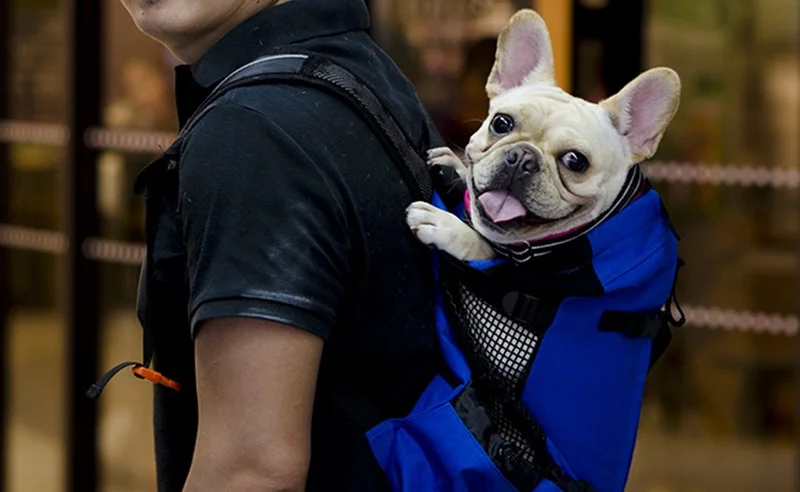If you’re an adventurous dog owner, you might have wondered about the possibility of carrying your furry friend in a backpack during your outdoor escapades. Whether you’re hiking, biking, or traveling, having your dog close by can be a wonderful experience. However, it’s crucial to prioritize your pup’s safety and comfort when considering this mode of transportation. In this comprehensive guide, we’ll explore everything you need to know about carrying your dog in a backpack. So let’s dive in and learn how to embark on backpacking adventures with your four-legged companion like a pro.
1: Choosing the Right Backpack
————————————————-
There are many types of backpacks for carrying a dog:
Front Backpacks: Front backpacks, also known as chest carriers, are worn on the front of the owner’s body with the dog facing forward. They allow for close interaction between the dog and owner and are suitable for small dogs or those who prefer to stay close to their owner.
Sling Backpacks: Sling backpacks are worn over the shoulder and across the owner’s body, with the dog sitting or lying inside the sling. They provide a cozy and secure carrying option for smaller dogs and are suitable for short outings or urban environments.
Carrier Backpacks: These backpacks are designed like traditional backpacks but with a built-in carrier compartment for the dog. The carrier can be opened to allow the dog to poke their head out or closed for a more secure and enclosed space. Carrier backpacks are ideal for small dogs or those who prefer a more enclosed space.
Hydration Backpacks: Hydration backpacks have a built-in water reservoir and a drinking tube, allowing both the owner and dog to stay hydrated during outdoor activities. These backpacks often have additional storage compartments for other items.
Cooling Backpacks: Cooling backpacks are designed with cooling technology, such as gel packs or breathable materials, to help keep the dog cool during hot weather or intense activities. They are particularly useful for dogs prone to overheating.
When selecting a backpack, consider your dog’s size and weight. Choose a backpack that can comfortably accommodate your dog’s dimensions while still maintaining a proper weight distribution for you. It’s important to adhere to the weight capacity specified by the manufacturer to avoid strain or discomfort.
Additionally, look for backpacks that have features like padded compartments, adjustable straps, and reinforced bottoms to provide comfort and stability for your pup. Mesh panels and ventilation openings help ensure proper airflow and prevent overheating. It is also important that the backpack is not too tight around your dog’s body, allowing them to breathe freely.
2: Preparing Your Dog for the Adventure
———————————————————
2.1 Gradual Introduction to the Backpack:
Introduce your dog to the backpack gradually to help them acclimate to the new experience. Start by allowing your dog to investigate the backpack in a familiar and comfortable environment. Gradually progress to short walks or hikes with the backpack, gradually increasing the duration and difficulty. When they become accustomed to the outdoor surroundings, you will have a more enjoyable backpacking experience!
2.2 Packing Essential Items for Your Dog:
Pack essential items for your dog’s comfort and well-being in the backpack. These may include food, water, collapsible bowls, waste bags, a leash, any necessary medications, a first aid kit, and a familiar blanket or toy.
3: During the Adventure
————————————————-
3.1 Checking for Proper Alignment and Posture:
Regularly check your dog’s posture and alignment while in the backpack. Their spine should remain straight and their limbs should be able to move freely without restriction. Adjust the backpack’s straps and padding as necessary to maintain proper alignment and prevent strain on your dog’s body. A well-fitted backpack will distribute the weight evenly and keep the center of gravity aligned with your body.
3.2 Monitoring Temperature and Hydration:
Pay attention to the temperature and humidity levels during your backpacking adventures. Dogs can overheat quickly, especially when carried in a backpack. Monitor your dog for signs of overheating such as excessive panting, drooling, or lethargy. Take regular breaks, offer water, and find shaded areas to cool down if needed. During breaks, allow your dog to stretch their legs and move around freely. This will help prevent stiffness and promote circulation. Supervise your dog closely to ensure they stay within a safe distance and avoid hazardous areas.
3.3 Monitoring Signs of Discomfort or Fatigue:
Pay close attention to your dog’s behavior and body language throughout the backpacking trip. Look for signs of discomfort, fatigue, or distress, such as excessive panting, lagging behind, or reluctance to continue. If your dog shows any signs of distress, take immediate action to address their needs and ensure their well-being.
3.4 Being a Responsible Dog Owner:
As a responsible dog owner, it’s your duty to ensure the safety and well-being of your dog, as well as the enjoyment of others on the trail. Be considerate of other hikers and their preferences regarding dogs. Keep your dog under control, clean up after them, and be mindful of their behavior to maintain a positive experience for everyone involved.
Carrying your dog in a backpack can be a fantastic way to share adventures and create lasting memories. So, gear up, leash up, and get ready to explore the great outdoors with your loyal companion by your side. Happy backpacking!

